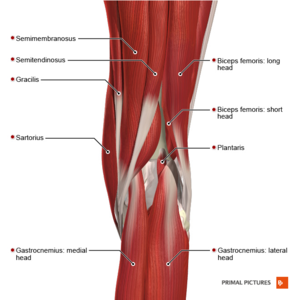Manual Muscle Testing: Knee Flexion: Difference between revisions
Claire Knott (talk | contribs) No edit summary |
No edit summary |
||
| (3 intermediate revisions by 2 users not shown) | |||
| Line 1: | Line 1: | ||
= | <div class="editorbox"> | ||
'''Original Editor '''- Claire Knott | |||
'''Top Contributors''' - {{Special:Contributors/{{FULLPAGENAME}}}} | |||
</div> | |||
== Introduction == | |||
[[File:Superficial muscles of the knee posterior aspect Primal.png|thumb|Muscles of the knee (posterior)]] | |||
An assessment of [[muscle]] strength is typically performed as part of a patient's [[Outcome Measures|objective assessment]] and is an important component of the physical exam that can reveal information about neurologic deficits. It is used to evaluate weakness and can be effective in differentiating true weakness from imbalance or poor endurance. See [[Muscle Strength Testing]] | |||
== Muscles Involved == | |||
The [[Knee Flexors|knee flexors]] include the set of [[hamstrings]], [[gracilis]], [[sartorius]], [[Gastrocnemius|gastrocnemius,]] [[plantaris]], and [[Popliteus Muscle|popliteus]]. The Hamstrings group are the main knee flexors | |||
* [[Biceps Femoris|Biceps femoris]] | |||
* [[Semitendinosus]] | |||
* [[Semimembranosus|Semimembranosus]] | |||
== Patient Positioning == | == Patient Positioning == | ||
* Grades 3 to 5 - Patient is in prone, knee extended | * Grades 3 to 5 - Patient is in prone, knee extended | ||
* Grades 0-2 - Patient is in side lying, knee extended | * Grades 0-2 - Patient is in side lying, knee extended ('gravity minimal' position) | ||
== Therapist Position == | == Therapist Position == | ||
| Line 19: | Line 24: | ||
== To Test == | == To Test == | ||
* Patient actively flexes the knee through range. | * Patient actively flexes the knee through range. | ||
* For grades 4 to 5 apply resistance through the distal tibia and fibula in a direction opposite to flexion | * For grades 4 to 5 apply resistance through the distal tibia and fibula in a direction opposite to flexion To satisfy grade 5 'normal muscle' performance criteria, the patient must have the ability to move through complete range of motion (active resistance testing) '''OR''' maintain an end point range (break testing) against maximum resistance. | ||
== Biasing Muscle Groups == | == Biasing Muscle Groups == | ||
Latest revision as of 06:04, 17 February 2022
Original Editor - Claire Knott
Top Contributors - Claire Knott, Wanda van Niekerk and Lucinda hampton
Introduction[edit | edit source]
An assessment of muscle strength is typically performed as part of a patient's objective assessment and is an important component of the physical exam that can reveal information about neurologic deficits. It is used to evaluate weakness and can be effective in differentiating true weakness from imbalance or poor endurance. See Muscle Strength Testing
Muscles Involved[edit | edit source]
The knee flexors include the set of hamstrings, gracilis, sartorius, gastrocnemius, plantaris, and popliteus. The Hamstrings group are the main knee flexors
Patient Positioning[edit | edit source]
- Grades 3 to 5 - Patient is in prone, knee extended
- Grades 0-2 - Patient is in side lying, knee extended ('gravity minimal' position)
Therapist Position[edit | edit source]
- Therapist to stand at test side in prone
- If patient is in side lying, therapist to stand behind the patient support the lower leg through movement as required.
To Test[edit | edit source]
- Patient actively flexes the knee through range.
- For grades 4 to 5 apply resistance through the distal tibia and fibula in a direction opposite to flexion To satisfy grade 5 'normal muscle' performance criteria, the patient must have the ability to move through complete range of motion (active resistance testing) OR maintain an end point range (break testing) against maximum resistance.
Biasing Muscle Groups[edit | edit source]
- To bias laterally-inserting muscles: externally rotate the tibia in combination with flexion
- To bias medially-inserting muscles: internally rotate the tibia in combination with flexion[1]
References[edit | edit source]
- ↑ Hislop H, Avers D, Brown M. Daniels and Worthingham's muscle Testing-E-Book: Techniques of manual examination and performance testing. Elsevier Health Sciences; 2013 Sep 27.







